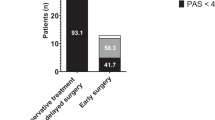Abstract
We treated 12 patients with pituitary apoplexy out of 103 patients with pituitary tumors from August 1994 to March 2008 in the Nishi-Kobe Medical Center. The male to female ratio was 1:2 and the average age was 43 years old, ranging from 19 to 73. The symptoms on presentation were a decrease of visual acuity in nine, headache in seven, endocrinological disturbance in six, visual field defect in seven, a febrile state in six, vomiting in four, oculomotor disturbance in two, abducens palsy in one, and transient altered consciousness in one. All patients underwent transsphenoidal surgery and, in four of these, surgery was conducted within 7 days after onset. All nine patients with a decrease in the visual acuity recovered (100%) and, in addition, complete or near-complete vision recovery was noted in six out of eight patients (75%), excluding one patient whom we were unable to examine accurately. Emergent surgery was performed for only two patients with an acute deterioration of the visual acuity, with one finally developing complete blindness. Based on this study, we conclude that decompressive surgery is very useful for decreased visual acuity caused by pituitary apoplexy, but it is not necessary to perform emergent surgery for pituitary apoplexy in the absence of severe visual deterioration.

Similar content being viewed by others
Abbreviations
- Good:
-
Recovered nearly to the baseline acuity before onset
- Fair:
-
Did not recover to the baseline acuity before onset
References
Lubina A, Olchovsky D, Berezin M, Ram Z, Hadani M, Shimon I (2005) Management of pituitary apoplexy: clinical experience with 40 patients. Acta Neurochir(Wien) 147:151–157
Wakai S, Fukushima T, Teramoto A, Sano K (1981) Pituitary apoplexy:its incidence and clinical significance. J Neurosurg 55:187–193
Bonicki W, Kasperlik-Zaluska A, Koszewski W, Zgliczyński W, Wislawski J (1993) Pituitary apoplexy: endocrine, surgical and oncological emergency. Incidence, clinical course and treatment with reference to 799 cases of pituitary adenomas. Acta Neurochir (Wien) 120:118–122
Ayuk J, McGregor EJ, Mitchell RD, Gittoes NJL (2004) Acute management of pituitary apoplexy-surgery or conservative management? Clin Endocrinol 61:747–752
Verrees M, Arafah BM, Selman WR (2004) Pituitary tumor apoplexy: characteristics, treatment, and outcomes. Neurosurg Focus 16:1–7
Onesti ST, Wisniewski T, Post KD (1990) Clinical versus subclinical pituitary apoplexy: Presentation, surgical management, and outcome in 21 patients. Neurosurgery 26:980–986
McFadzean RM, Doyle D, Rampling R, Teasdale E, Teasdale G (1991) Pituitary apoplexy and its effect on vision. Neurosurgery 29:669–675
Ebersold MJ, Edward RL Jr, Scheithauer BW, Randall RV (1983) Pituitary apoplexy treated by transsphenoidal surgery. A clinicopathological and immunocytochemical study. J Neurosurg 58:315–320
l’Huillier F, Combes C, Martin N, Leclerc X, Pruvo JP, Gaston A (1989) MRI in the diagnosis of so-called pituitary apoplexy:seven cases. J Neuroradiol 16:221–237
Vidal E, Cevallos R, Vidal J, Ravon R, Moreau JJ, Rogues AM, Loustaud V, Liozon F (1992) Twelve cases of pituitary apoplexy. Arch Intern Med 152:1893–1899
Chanson P, Lepeintre J-F, Ducreux D (2004) Management of pituitary apoplexy. Expert Opin Pharmacother 5:1287–1298
Bills DC, Meyr FB, Laws ER, Davis DH, Ebersold MJ, Scheithauer BW, Ilstrup DM, Abboud CF (1993) A retrospective analysis of pituitary apoplexy. Neurosurgery 33:602–609
Randeva HS, Schoebel J, Byrne J, Esiri M, Asams CBT, Wass JAH (1999) Classical pituitary apoplexy: clinical fertures, management and outcome. Clin Endocrinol 51:181–188
Agrawal D, Mahapatra AK (2005) Visual outcome of blind eyes in pituitary apoplexy after transsphenoidal surgery: a series of 14 eyes. Surg Neurol 63:42–46
Maccagnan P, Macedo CLD, Kayath MJ, Nogueira RG, Abucham J (1995) Conservative management of pituitary apoplexy: a prospective study. J Clin Endocrinol Metab 80:2190–2197
Arafah BM, Harrington JF, Madhoun ZT, Selman WR (1990) Improvement of pituitary function after surgical decompression for pituitary tumor apoplexy. J Clin Endocrinol Metab 71:323–328
Rolih CA, Ober KP (1993) Pituitary apoplexy. Endocrinol Metab Clin North Am 22:291–302
Sibal L, Ball SG, Connolly V, James RA, Kane P, Kelly WF, Taylor PK, Mathias D, Perros P, Quinton R, Vaidya B (2005) Pituitary apoplexy: a review of clinical presentation, management and outcome in 45 cases. Pituitary 2004 Published online:11 July 2005
Gruber A, Clayton J, Kumar S, Robertson I, Howlett TA, Mansell P (2006) Pituitary apoplexy: retrospective review of 30 patients-is surgical intervention always necessary? Br J Neurosurg 20(6):379–385
Muthukumar N, Rossette D, Soundaram M, Senthibabu S, Badrinarayanan T (2008) Blindness following pituitary apoplexy: timing of surgery and neuro-ophthalmic outcome. J Clin Neurosci 15(8):873–879
Author information
Authors and Affiliations
Corresponding author
Rights and permissions
About this article
Cite this article
Takeda, N., Fujita, K., Katayama, S. et al. Effect of transsphenoidal surgery on decreased visual acuity caused by pituitary apoplexy. Pituitary 13, 154–159 (2010). https://doi.org/10.1007/s11102-009-0216-9
Published:
Issue Date:
DOI: https://doi.org/10.1007/s11102-009-0216-9



